
* The Phantom was a step forward in aircraft design, incorporating many new features when it was introduced in the late 1950s. In the following decades, new Phantom variants were developed to enhance its capabilities, as well as adapt it to new roles, such as reconnaissance and defense suppression. This chapter describes the different variants of the Phantom in US service. A few other variants that only flew in foreign service are discussed in a following chapter.
* The initial XF4H-1 prototype performed its first flights with J79-GE-3 engines, but was then refitted with J79-GE-2s and finally J79-GE-2As, providing 46.0 kN (4,695 kgp / 10,350 lbf) dry thrust and 71.8 kN (7,325 kgp / 16,150 lbf) afterburning thrust each.
The 19th aircraft built replaced the AN/APQ-50 radar set with the evolved AN/APQ-72, which had a larger antenna that required fit of a new and bigger nose. That gave the Phantom a "droopy nose" appearance that made it look even more awkward, and also dictated a new canopy scheme. Earlier aircraft had a canopy that was flush with the aircraft's spine -- but with the 19th aircraft and every other Phantom ever built, the cockpit was raised and bulged to give a better view over the big nose. Forward visibility was still not the best and rearward visibility was terrible, though the raised cockpit did also improve the view to the back a bit.
The 46th aircraft introduced fully-rated J79-GE-8 engines with 48.5 kN (4,945 kgp / 10,900 lbf) dry thrust and 75.6 kN (7,710 kgp / 17,000 lbf) afterburning thrust each, along with minor modifications to the engine installation.
In March 1961, the first 45 Phantoms, following the two XF4H-1 prototypes, were retroactively given the new designation of "F4H-1F", while the others in this series retained the F4H-1 designation. The F4H-1Fs were all evaluation and test aircraft; none of them ever reached operational service.
Full-production F4H-1s were in service with the US Navy and Marine Corps by 1962. In September of that year, the US military adopted a tri-service aircraft designation scheme, and the F4H-1F became the "F-4A" and the F4H-1 became the "F-4B". A total of 649 F-4Bs was built from 1961 to 1967.
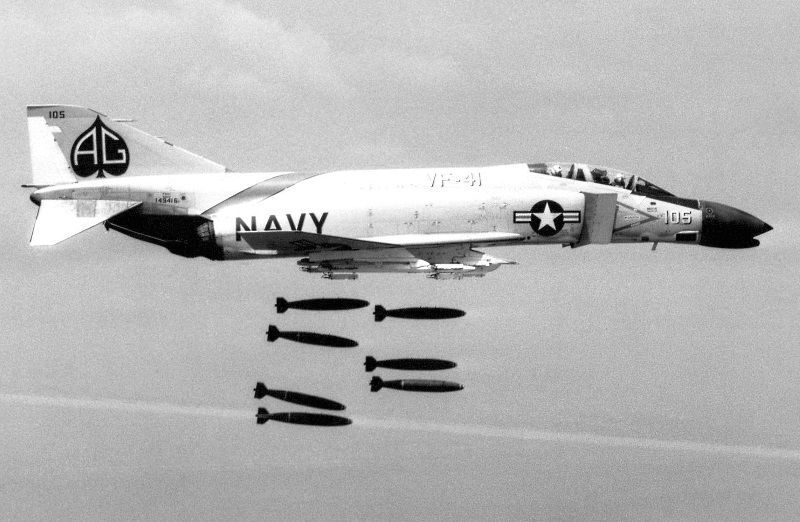
Of total F-4B production, 12 were built with an AN/ASW-21 datalink for an automatic carrier landing system, along with an "automatic approach compensation (AAC)" system that performed automatic throttle control on carrier approaches to ensure constant speed. These aircraft were designated "F-4G", with the first flying in March 1963. The new electronics gear was fitted in a compartment in the upper forward fuselage, created by chopping off an edge of the forward fuselage fuel cell.
The F-4Gs went through operational evaluation in Southeast Asia in 1965:1966. They were then returned to the F-4B specification, suggesting that the AAC system was unsuccessful -- but the F-4G designation would be "recycled" in a later Phantom variant, see below. The new avionics compartment was carried on to other variants.
* Between 1972 and 1974, 226 Navy and Marine F-4Bs were put through an update program with structural strengthening, new wiring, 30-kilowatt electrical power generators, and new avionics. The updated aircraft were known as "F-4Ns".
BACK_TO_TOP* Robert S. McNamara, US secretary of defense in the Kennedy and Johnson Administrations, was very enthusiastic about "commonality" between the different US armed services. He wanted the services to adopt common equipment to reduce acquisition, logistical, and training costs. In 1961, the word came down that the USAF should evaluate the Navy Phantom. The Navy loaned what would eventually be a total of 29 F-4Bs for the evaluation.
Such attempts to enforce commonality didn't always work out well, partly due to interservice rivalries, plus the fact that the services sometimes really did have clearly different needs and requirements. The Phantom, however, worked out very well. The evaluation showed the Air Force that the Phantom, even though it carried the weight of additional gear required for carrier operations, was a match or more for existing Air Force fighters. The USAF would eventually acquire over twice as many Phantoms as the Navy and Marine Corps combined.
In the spring of 1962, the USAF decided to adopt the Phantom, under the initial designation of "F-110A Spectre", which was applied to the loaned Navy F-4Bs then being evaluated by the Air Force. A USAF-optimized variant actually went into service as the "F-4C", retaining the Navy Phantom name, with the first example of the variant flying on 27 May 1963. 563 were built to 1966. The F-4C was very similar to the F-4B, even retaining arresting gear and folding wings, but featured a number of changes:
After the F-4C went to Vietnam in 1965 a number of problems emerged, including fuel leaks and poor tolerance to humidity. A field update program was implemented to address the problems.
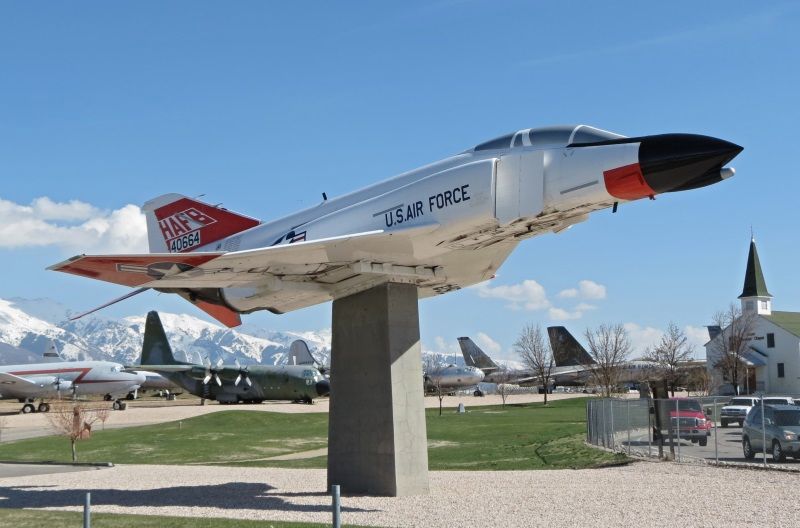
* The F-4C was followed in USAF service by the "F-4D", which performed its first flight on 9 December 1965, leading to initial service deliveries in 1966. The F-4D would be the USAF's workhorse over Southeast Asia. 825 were built to 1968.
The F-4D airframe was basically the same as that of the F-4C; the primary enhancements were in avionics, particularly AN/APQ-109 radar. The AN/APQ-109 was an improved, more reliable "hybrid" version of the AN/APQ-100 with solid-state components in the low-voltage sections. The F-4D also featured new attack and navigation systems, and uprated 30-kilowatt electric power generators.
Since combat experience over Southeast Asia had shown the need for a gun, a 20-millimeter cannon pod designated the "SUU-16/A" was hastily introduced, to be eventually replaced by the similar but improved "SUU-23/A" pod. The F-4D was wired for carriage of the cannon pod, and had an ASG-22 lead-computing gunsight fitted for aiming it. Apparently some F-4Cs were also retrofitted to carry cannon pods.
The AN/AAA-4 IRST was deleted in most F-4D production, since it had proven useless in practice. Confusingly, late production F-4Ds were fitted with the fairing used for the AN/AAA-4, but it contained elements of an AN/APR-25/26 radar warning receiver (RWR), not an infrared sensor.
BACK_TO_TOP* Combat experience led to the definitive Air Force "F-4E", which performed its initial flight on 30 June 1967. The F-4E featured:
The F-4E became the primary USAF variant, and was also heavily exported, as is discussed later. Including exports, 1,387 were built to 1979.
___________________________________________________________________
MCDONNELL DOUGLAS F-4E PHANTOM II:
___________________________________________________________________
wingspan:
11.77 meters (38 feet 8 inches)
wing area:
49.24 sq_meters (530 sq_feet)
length:
19.2 meters (63 feet)
height:
5.02 meters (16 feet 6 inches)
empty weight:
13,760 kilograms (30,330 pounds)
loaded weight:
28,030 kilograms (61,795 pounds)
max speed at altitude:
2,415 KPH (1,500 MPH / 1,305 KT)
service ceiling:
16,580 meters (54,400 feet)
combat radius:
1,265 kilometers (785 MI / 680 NMI)
___________________________________________________________________
* The F-4E was enhanced during and after its production. One of the particular limitations of the Phantom was that it had been designed basically as an interceptor and strike aircraft, not a dogfighter, and maneuverability had suffered as a result. The lack of maneuverability proved troublesome in combat -- in the worst case, under certain aggressive flight conditions the F-4 could go into a spin that generally required immediate ejection if the aircraft was below 3,000 meters (10,000 feet).
This unpleasant behavior came as something of a nasty shock, since flying the Phantom under peacetime conditions was very straightforward, one pilot calling it "idiot-proof", and it had an admirable flight safety record. Once heavily laden with external stores, however, its center of gravity moved backwards, making it more prone to spins.
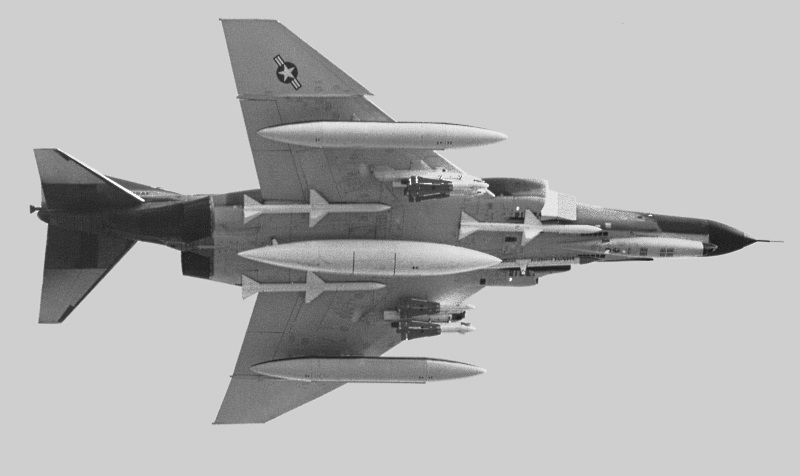
In response to the maneuverability problems, a program named AGILE EAGLE was initiated, in which the Phantom was fitted with various experimental aerodynamic modifications. The solution in the end was to fit the wing with leading-edge slats, which extended automatically when the aircraft's AOA exceeded six degrees, and retracted when the AOA went back to four degrees. The slats replaced the leading-edge flaps; installation of the slats required removal of the BLC system. The leading-edge slats were introduced into F-4Es beginning in mid-1972 and were retrofitted to older aircraft. Beginning the next year, 1973, F-4Es went through a structural strengthening program after an F-4E was lost due to a wing structural failure.
The Northrop "Target Identification System Electro-Optical (TISEO)" camera system was also introduced in late F-4E production, being retrofitted to older aircraft as well. TISEO involved a steerable, stabilized telescopic camera mounted on the left wing, and was used primarily to inspect targets before engaging them. TISEO imagery was displayed on the WSO's radarscope. The camera could be slaved to the AN/APQ-120 radar, and apparently there was an upgrade that allowed it to be linked to the navigation system to target flight checkpoints as well. Of course, it was a daylight / clear-weather only system. Most export F-4Es were not fitted with TISEO.
BACK_TO_TOP* The Navy and Marines procured a variant similar to the F-4E, designated the "F-4J", with the following improvements:
Three F-4Bs were rebuilt as "YF-4J" prototypes, with the first prototype performing its initial flight on 27 May 1966. 522 new-build F-4Js were manufactured to 1972, following the prototype conversions. A special version of the F-4J was proposed for the USMC but not built, this aircraft being intended to feature an enhanced fire-control system and F-4E-style leading-edge maneuvering slats.
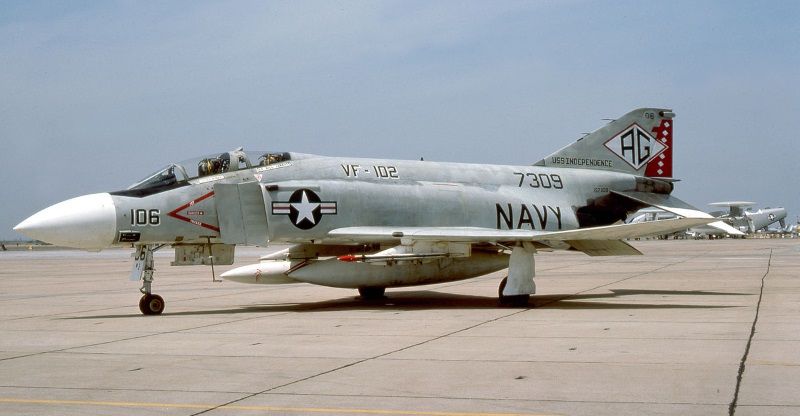
Incidentally, the "F-4F" was a specialized Phantom variant flown only by the German Luftwaffe, discussed later; while the "F-4H" designation was not used, since it might have caused confusion with the old "F4H" designation. The "F-4I" designation wasn't used either, since it could be misinterpreted as "F-41".
* Beginning in 1978 248 F-4Js were brought up to "F-4S" standards, with structural strengthening; leading-edge slats; a substantially updated AN/AWG-10A radar set and other new avionics; and uprated J79-GE-10B engines, which also featured engine improvements to eliminate the tendency of the J79 to leave behind a trail of dirty smoke, a liability in combat. Fit of the leading-edge slats required removal of the BLC system.
* There were also some unusual or unbuilt Phantom variants. The 226th Phantom built was used as an experimental platform. It started life as an F-4B, to be reconfigured as the prototype for several Phantom variants. In 1972, it was given a fly-by-wire (FBW) control system, and was later given canard foreplanes. This aircraft was retired and donated to the US Air Force Museum in Dayton, Ohio, in 1978.
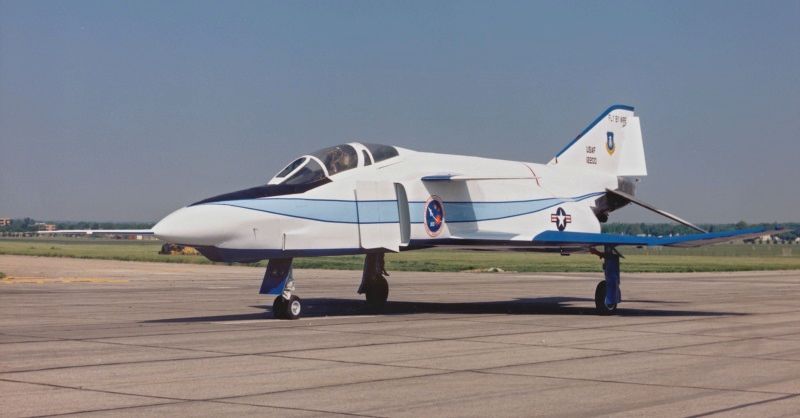
In the late 1970s, McDonnell Douglas proposed an air superiority variant of the F-4E designated the "F-4T" that would have deleted all gear needed for ground attack. Nothing came of the notion.
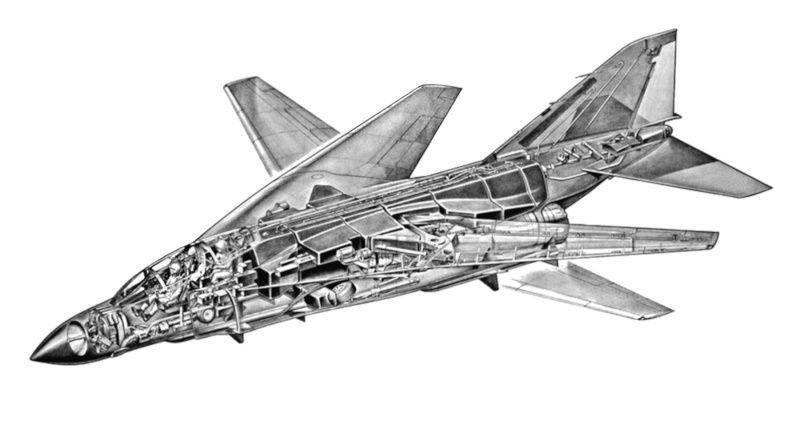
The most dramatic proposed modification of the Phantom was a "swing wing" or "variable geometry" derivative of the F-4J, designated the "F-4 (FVS)", promoted in the mid-1960s by McDonnell. The wings would be shoulder-mounted and would be able to sweep from 23 to 75.5 degrees. The Navy was very leery of this idea, since the service wanted a new fighter instead of an updated version of an older one, and lobbied successfully for the Grumman F-14 Tomcat instead.
BACK_TO_TOP* Although the Air Force had some entirely understandable resistance to acquiring a Navy fighter, after adopting the Phantom the USAF quickly became very enthusiastic about the type. Shortly after ordering their first production Phantom fighters, the service decided to acquire a reconnaissance variant to replace their current McDonnell RF-101 Voodoo. The "recce" (pronounced "rekky") Phantom was originally designated the "RF-110A", but was redesignated "RF-4C" in September 1962.
The Phantom was adapted to the reconnaissance role through fit of a new forward fuselage to carry cameras and other reconnaissance gear. Initial flight of the first of two "YRF-4C" prototypes was on 8 August 1963. 505 RF-4Cs, including the two prototypes, were built to 1974.
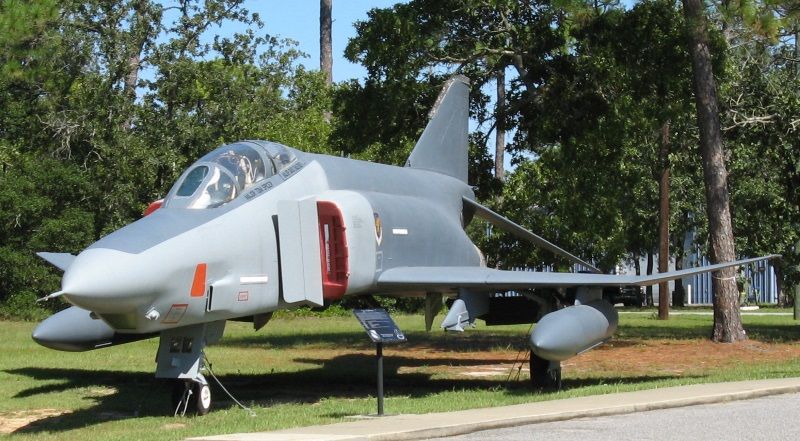
The cameras were fitted in a new nose that stretched the aircraft's length by 84 centimeters (33 inches). The wing-mounted pitot tube was moved to the nose from the leading edge of the tailfin as well, resulting in a total increase in length of 147 centimeters (57.8 inches). As noted, a modified version of this nose was fitted to the F-4E to accommodate the M61 cannon, and resulted in the same increase in length.
The RF-4C's nose featured three camera "stations" that could be configured by ground crews with different camera fits:
In addition to the cameras, the RF-4C carried electronic reconnaissance gear, as well as systems to support the reconnaissance mission:
The RF-4C could also be fitted with electronic intelligence (ELINT) systems carried in pods on stores pylons.
The RF-4C was not kitted up to get into fights. Fire control systems were deleted; the recesses for Sparrow missiles under the fuselage were faired over, since the RF-4C didn't have the radar to guide the Sparrows; and the pilot's weapons sight was replaced by an LA-313 optical viewfinder to help target camera shots.
Instead of an AN/APQ-100 radar set, the RF-4C was fitted with a more compact Texas Instruments AN/APQ-99 forward-looking radar set, intended to support air navigation instead of combat. The AN/APQ-99 provided a ground mapping capability, along with terrain-following and terrain-avoidance modes. The RF-4C also featured an improved AN/ASN-56 INS, and a long-range HF communications system. Although in Air Force terminology the back-seater was still known as WSO, since the RF-4C didn't have any weapons, he was more often known simply as the "navigator".
Following the Vietnam War, USAF RF-4Cs were given various upgrades to keep them up to date, the most important being fit of the AN/ALQ-125 ELINT system.
* The RF-4C's nose and reconnaissance gear was fitted to the F-4B airframe to yield the "RF-4B" for the US Marine Corps, with initial flight on 12 March 1965, leading to operational introduction in May 1965. The equipment fit differed slightly from the RF-4C's in that the station 2 cameras could be rotated in flight.
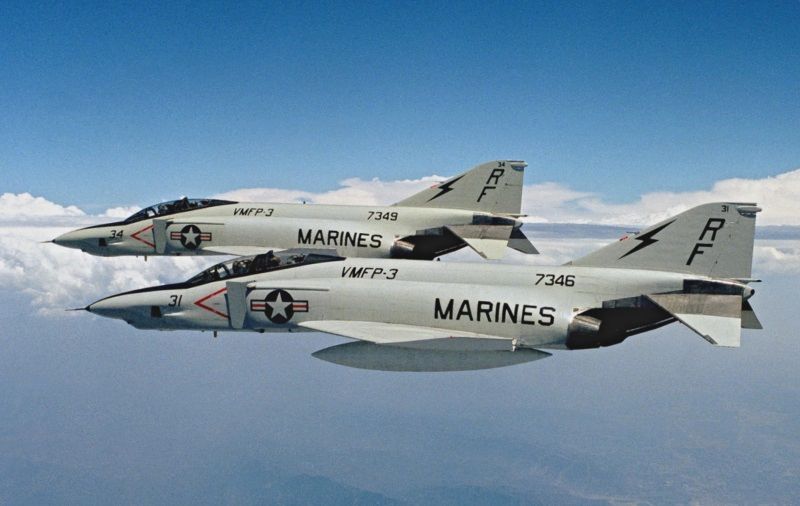
The RF-4B actually followed the F-4C into service, reversing the usual sequence of subvariant codes. The RF-4B was strictly a Marine machine; the Navy did not use the type since that service had no requirement for it, relying on the RF-8A Crusader and RA-5C Vigilante for the reconnaissance role. 46 RF-4Bs were built. The last ten were odd hybrids, with the original RF-4B nose, RF-4C fuselage and tail, and F-4J wings. In the last half of the 1970s, the RF-4Bs were given a substantial update under Project SURE, involving structural strengthening, new reconnaissance systems, a datalink, defensive countermeasures, and other avionics.
* The F-4E was fitted with a recce nose to yield the "RF-4E". Initial flight of the prototype was on 15 September 1970, and 146 were built, strictly for the export market. Late production F-4Es had a modified nose that was less angular than earlier recce Phantoms. RF-4Es also had slight variations in equipment fit for their specific customers.
By this time, the Phantom was properly known as the "McDonnell Douglas" Phantom, since the two companies had merged in 1967. Three decades later, McDonnell Douglas would be bought out by Boeing, but nobody would think to call an F-4 a "Boeing Phantom".
BACK_TO_TOP* The last Phantom was rolled out of the McDonnell Douglas factory at Saint Louis on 26 October 1979, after manufacture of 5,057 of the type there, not counting 138 assembled or built in Japan, as discussed later. However, given the widespread use of the type, that was by no means the end of the story.
One of the nasty surprises encountered by the US military in Vietnam was the effectiveness of North Vietnamese air defenses, and so developing counter-defenses was a high priority. One possible counter-defense was a "defense suppression" aircraft that could target air-defense radars and attack surface-to-air missile (SAM) sites, and this led to the "Wild Weasel" series of "defense-suppression" aircraft.
The original "Wild Weasel I" was a modified tandem-seat F-100F Super Sabre, but this aircraft could not keep up with strike packages, and amounted to a proof-of-concept system. It was followed into service by the "Wild Weasel II", a modified F-105F Thunderchief, and then a more optimized F-105F modification, the F-105G "Wild Weasel III", which performed the burden of defense suppression over North Vietnam.
Late in the war, about 36 F-4Cs were modified to the "Wild Weasel IV" configuration, carrying radar detection and targeting systems along with the AGM-45 "Shrike" anti-radar missile (ARM), which was a Sparrow with a radar-seeking head. The Wild Weasel IV conversion left something to be desired, and after the war 116 F-4Es were converted into the "Wild Weasel V" or "Advanced Wild Weasel", which was given the "vacant" designation "F-4G".
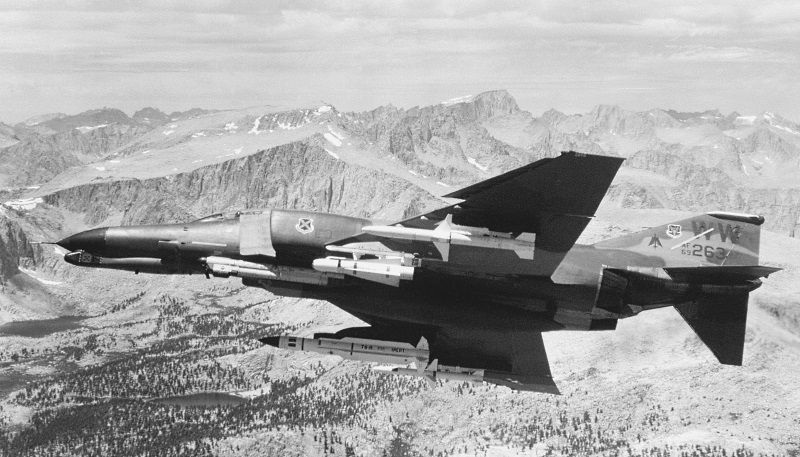
The nose cannon was deleted, with the space occupied taken up by gear for an AN/APR-38 RHAWS, with 52 antennas littered over the fuselage. Combat avionics systems were retained. The AN/APR-38 could not only locate and identify radar emitters, it could also target them for attack with ARMs, or cluster bombs and other munitions. At first, the F-4G carried the Shrike, but in the early 1980s this missile was generally replaced by the Texas Instruments AGM-88 "High Speed Anti-Radiation Missile (HARM)", more or less a scaled-up Shrike with a better seeker system. The HARM would become the F-4G's most characteristic weapon.
BACK_TO_TOP* With plenty of retired Phantoms available, it is unsurprising that the type was favored for conversion into high-performance target drones. Some F-4Bs were converted to "QF-4B" target drones and "DF-4B" drone controllers, and as later Phantom variants were removed from first-line service, they were often converted to target drones as well, collectively referred to simply as "QF-4s". The conversions cost a few million USD each.
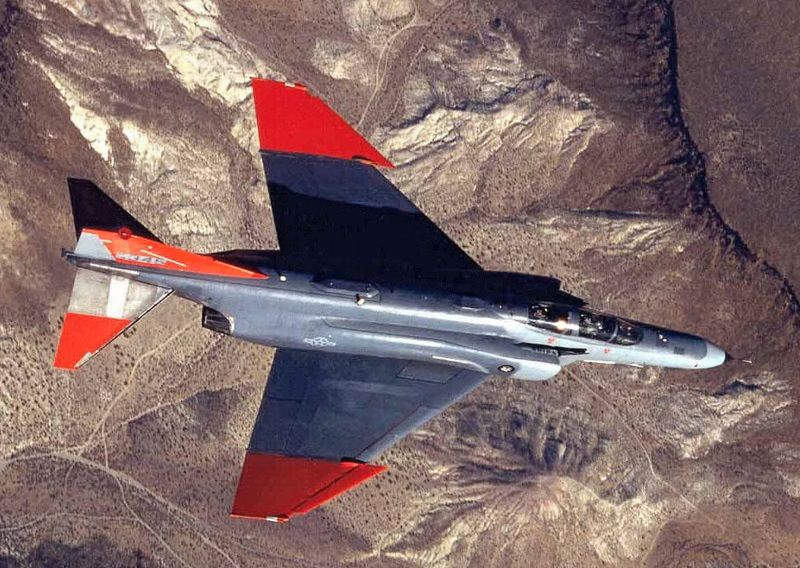
Interestingly, some of the QF-4s retained a piloted capability. This was because test and training scenarios require a high degree of choreography to make them as realistic as possible, and so pilots had to fly the QF-4s through "dry runs" to ensure that all details were considered. The USAF referred to unpiloted flights using the acronym "NULLO (Not Utilizing Local Live Operator)", while the Navy more tidily called them "NOLO (No Onboard Live Operator)".
Up to four QF-4s could be flown in formation during NULLO flights. The drones did not interact with each other, they were simply commanded to follow a specific moving point in space known as a "rabbit", with each aircraft maintaining a specific three-dimensional offset from the rabbit. The autopilot system on the QF-4 was very sophisticated; for example, the remote operator could land the aircraft simply by giving it a single command to land.
Although missiles used in air combat tests don't usually have combat warheads, once a QF-4 was used as an actual target in exercises, its predicted lifetime was no more than four missions. The QF-4 carried a self-destruct system to destroy itself if missile damage failed to shoot it down, leaving it as a potential threat to populated areas.
The last of 316 QF-4 conversions was delivered in late 2013. By that time, they were nearing the end of their useful lives even as targets, since they were unrepresentative of any adversary American pilots might face. The QF-4 was retired in early 2017, the type having been replaced by the "QF-16", converted from retired General Dynamics F-16A fighters.
BACK_TO_TOP